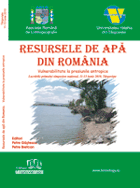11-13 June 2010. Water resources from Romania. Vulnerability to the pressure of man’s activities, Targoviste (Romania)

Resursele de apă din România. Vulnerabilitate la activităţile antropice
[Water resources from Romania. Vulnerability to the pressure of man’s activities]
Conference Proceedings
ISBN: 978-606-8042-65-7
11-13 June 2010, Targoviste - Romania
Editors
Petre Gâştescu
Petre Breţcan
ANALIZA PRESIUNILOR ANTROPICE ŞI A IMPACTULUI ACESTORA ASUPRA CORPURILOR DE APĂ DE SUPRAFAŢĂ – ETAPĂ IMPORTANTĂ ÎN REALIZAREA PLANURILOR DE MANAGEMENT
Elena ŢUCHIU
Administraţia Naţională “Apele Române”, Strada Edgar Quinet nr. 6, Sector 1, Bucureşti, elena.tuchiu@rowater.ro
Analysis of Anthropogenic Pressures and their impacts on surface water bodies – important step in elaboration of the river basin management plans
Abstract. The River Basin Management Plan represents the tool for the implementation of the Water Framework Directive and has as the main aim the sustainable and balanced water resources management and aquatic ecosystem protection, as well. According to the legal requirements, at the 22nd of December 2009, Romania has elaborated the first National Management Plan – synthesis of the River Basin Management Plans. The River Basin Management Plan is closely correlated with the socio-economical development, and an important stage in its elaboration is the pressure and impact assessment. This process of evaluation of the human pressures and theirs impacts on the water bodies leads to the identification of the water bodies which are at risk of failing the Water Framework Directive’ environmental quality objectives, having in view the following main steps: Identification of the driving forces and pressures; Identification of significant pressures; Impact assessment; Analysis of the risk of failling the environmental quality objectives. At the same time, for the pressures and impact assessment the DPSIR (Driver-Pressure-State-Impact-Response) approch has been used, thus the information/data on driving forces generating the pressures, changes of the water body status and the response (basic measures which will be taken for improvement of the water body status) have been used. Thus, there have been identified the following significant categories of anthropogenic pressures on the water bodies: point pollution sources, diffuse pollution sources, and hidromorphological alterations. Impact evaluation of different types of significant pressures has the goal of providing the information which are used in risk analysis and water status characterisation. For the risk assessment, there have been considered the following risk categories: pollution with organic substances, pollution with nutrients, pollution with hazardous substances and hydromorphological alterations, having in view that these 4 pressures’ categories have been identified the significant water management issues. The risk of failing the environmental objectives has been carried out in order to be used at:
- Caracterisation of the ecological status/potential and chemical status of the surface water bodies;
- Establishment of the supplementary measures;
- Application of the cost effectiveness and cost benefit analysis;
- Application of the exemptions.
© Asociatia Romana de Limnogeografie (2008)

